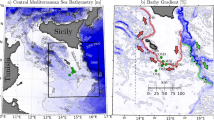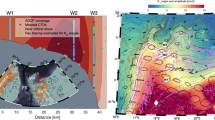Abstract
Observations of current velocity profiles and hydrography over and near a tall sill in a Chilean glacial fjord are used to illustrate the interactions between barotropic and baroclinic tides. The character of the barotropic tide in the glacial fjord is mixed with semidiurnal dominance. The ratio of sill height to water column depth at the study site is ca. 0.95. Water column stratification appeared only in the upper 5 m of the water column. Current velocity variations in the stratified surface layer were quite different to those underneath. Below the pycnocline, nonlinear interactions between semidiurnal M2 and diurnal K1 oscillations yielded a third-diurnal distortion MK3. Most interesting, surface layer currents were distortedby the superposition of semidiurnal M2 and sixthdiurnal M6 oscillations. The oscillations with M6 variability were identified, through wave superposition approaches, as reflected internal tides linked to M2 tidal variations. This was confirmed by theoretical results of stratified barotropic tidal flows interacting with abrupt bathymetry. Under the predominantly tidally mixed regime of the study area, the distortion to surface currents caused by the reflected wave was nearly symmetric during the large tidal ranges of the diurnal cycle. Nearly symmetric distortions resulted as the phase lag between incident and reflected wave-inducted currents was small (reflected currents developing a few minutes after maximum tidal flows). During the small ranges of the diurnal cycle, distortions were asymmetrical because of the relatively larger phase lags of the reflected signal (reflected currents developing tens of minutes after maximum tidal flows).
Similar content being viewed by others
Literature Cited
Allen, G. L. andJ. H. Simpson. 1998. Reflection of the internal tide in Upper Loch Linnhe, a Scottish Fjord.Estuarine Coastal Shelf Science 46:683–701.
Balmforth, N. J., G. R. Ierley, andW. R. Young. 2002. Tidal conversion by nearly critical topography.Journal of Physical Oceanography 32:2900–29414.
Blanton, J. O., G. Lin, andS. A. Elston. 2002. Tidal current asymmetry in shallow estuaries and tidal creeks.Continental Shelf Research 22:1731–1743.
Dworak, J. A. andJ. Gomez-Valdes. 2005. Modulation of shallow water tides in an inlet-basin system with a mixed tidal regime.Journal of Geophysical Research 110:C010007, doi: 10.1029/2003JC001865.
Friedrichs, C. T. andD. G. Aubrey. 1988. Nonlinear tidal distortion in shallow water mixed estuaries. A synthesis.Estuarine Coastal and Shelf Science 27:521–545.
Khatiwala, S.. 2003. Generation of internal tides in the ocean.Deep Sea Research I 50:3–21.
Larsen, L. H. 1969. Internal waves incident upon a knife edge barrier.Deep Sea Research 16:411–419.
Legg, S. andK. M. H. Huijts. 2006. Preliminary simulations of internal waves and mixing generated by finite amplitude tidal flow over isolated topography.Deep Sea Research II 53:140–156.
Llewellyn Smyth, S. G. andW. R. Young. 2002. Conversion of the barotropic tide.Journal of Physical Oceanography 32:1554–1566.
Parker, B. B. 1991. The relative importance of the various nonlinear mechanisms in a wide range of tidal interactions (review), p 237–268.In B. Parker (ed.), Tidal Hydrodynamics. John Wiley and Sons, New York.
Robinson, R. M.. 1969. The effects of a barrier on internal waves.Deep Sea Research 16:421–429.
Seim, H. E. andM. C. Gregg. 1997. The importance of aspiration and channel curvature in producing strong vertical mixing over a sill.Journal of Geophysical Research 102:3451–3472.
Speer, P. E. andD. G. Aubrey. 1985. A study of non-linear tidal propagation in shallow inlet/estuarine systems, Part II: Theory.Estuarine Coastal and Shelf Science 21:207–224.
St. Laurent, L., S. Stringer, C. Garret, andD. Perrault-Joncas. 2003. The generation of internal tides at abrupt topography.Deep Sea Research I 50:987–1003.
Stacey, M. W. andY. Gratton. 2001. The energetics and tidally induced reverse renewal in a two-silled fjord.Journal of Physical Oceanography 31:1599–1615.
Stacey, M. W., S. Pond, andZ. P. Nowak. 1995. A numerical model of the circulation in Knight Inlet, British Columbia, Canada.Journal of Physical Oceanography 25:1037–1062.
Valle-Levinson, A. andL. Atkinson 1999. Spatial gradients in the flow over an estuarine channel.Estuaries 22:179–193.
Valle-Levinson, A., J. L. Blanco, andM. Frangopulos. 2006. Hydrography and frontogenesis in a glacial fjord off the Strait of Magellan.Ocean Dynamics 56:217–227. DOI:10.1007/s10236-005-0048-8.
Valle-Levinson, A. andK. M. M. Lwiza. 1995. Effects of channels and shoals on the exchange between the lower Chesapeake Bay and the adjacent ocean.Journal of Geophysical Research 100: 18551–18563.
Author information
Authors and Affiliations
Corresponding author
Rights and permissions
About this article
Cite this article
Valle-Levinson, A., Blanco, J.L. & Frangópulos, M. Depth-dependent overtides from internal tide reflection in a glacial fjord. Estuaries and Coasts: J ERF 30, 127–136 (2007). https://doi.org/10.1007/BF02782973
Received:
Revised:
Accepted:
Issue Date:
DOI: https://doi.org/10.1007/BF02782973




